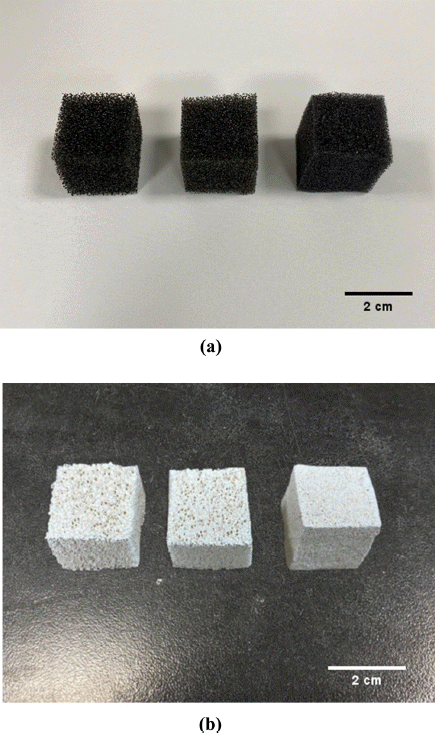Search
- Page Path
- HOME > Search
- [Korean]
- The Effects of Kaolin Addition on the Properties of Reticulated Porous Diatomite-kaolin Composites
- Chae-Young Lee, Sujin Lee, Jang-Hoon Ha, Jongman Lee, In-Hyuck Song, Kyoung-Seok Moon
- J Korean Powder Metall Inst. 2020;27(4):325-332. Published online August 1, 2020
- DOI: https://doi.org/10.4150/KPMI.2020.27.4.325

- 771 View
- 5 Download
-
 Abstract
Abstract
 PDF
PDF In this study, the effects of kaolin addition on the properties of reticulated porous diatomite-kaolin composites are investigated. A reticulated porous diatomite-kaolin composite is prepared using the replica template method. The microstructure and pore characteristics of the reticulated porous diatomite-kaolin composites are analyzed by controlling the PPI value (45, 60, and 80 PPI) of the polyurethane foam (which are used as the polymer template), the ball-milling time (8 and 24 h), and the amount of kaolin (0–50 wt. %). The average pore size decreases as the amount of kaolin increases in the reticulated porous diatomite-kaolin composite. As the amount of kaolin increases, it can be determined that the amount of inter-connected pore channels is reduced because the plate-shaped kaolin particles connect the gaps between irregular diatomite particles. Consequently, a higher kaolin percentage affects the overall mechanical properties by improving the pore channel connectivity. The effect of kaolin addition on the basic properties of the reticulated porous diatomite-kaolin composite is further discussed with characterization data such as pore size distribution, scanning electron microscopy images, and compressive strength.
- [Korean]
- Characterization of the Silica Coated Diatomite Based Ceramic Filter for Water Treatment
- Byung-Seo Bae, Jang-Hoon Ha, In-Hyuck Song, Yoo-Dong Hahn
- J Korean Powder Metall Inst. 2014;21(1):21-27. Published online February 1, 2014
- DOI: https://doi.org/10.4150/KPMI.2014.21.1.21

- 433 View
- 2 Download
-
 Abstract
Abstract
 PDF
PDF In this study, diatomite based materials were investigated as a support filter for silica particle coating. The silica sol for coating was synthesized by a stöber process. The diatomite support was dry-pressed at 10 MPa and sintered at 1200°C for 1 hour. The coating sol was prepared as a mixture of EtOH and silica sol. The diatomite support was coated by a dip-coating process. Silica coated diatomite filter was sintered at 1000~1200°C for 1 hour. The largest pore size was decreased with increasing concentration ratio of coating sol. The gas and water permeability of silica coated diatomite decreased with increasing of concentration ratio of the coating sol.
TOP
 KPMI
KPMI

 First
First Prev
Prev


